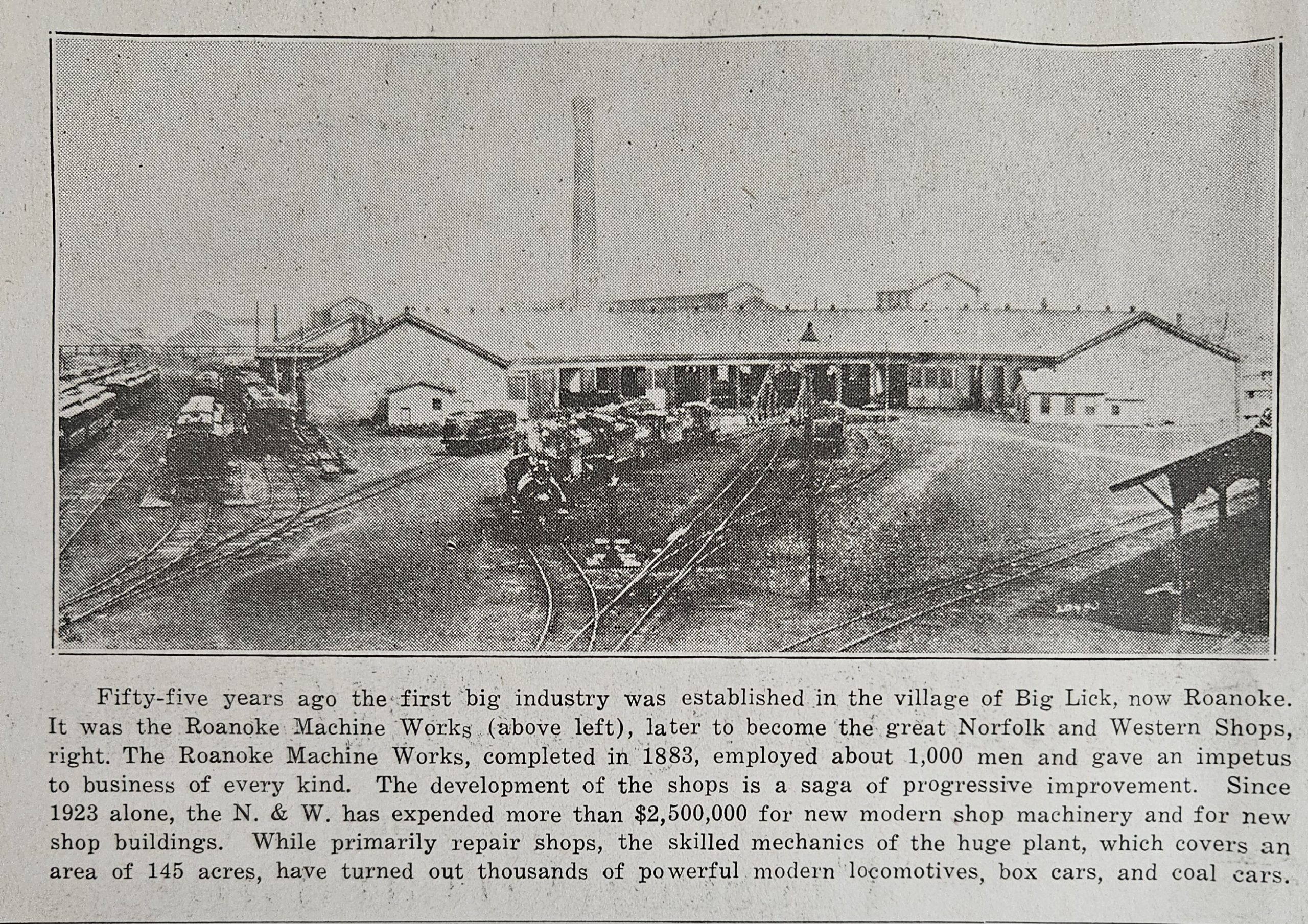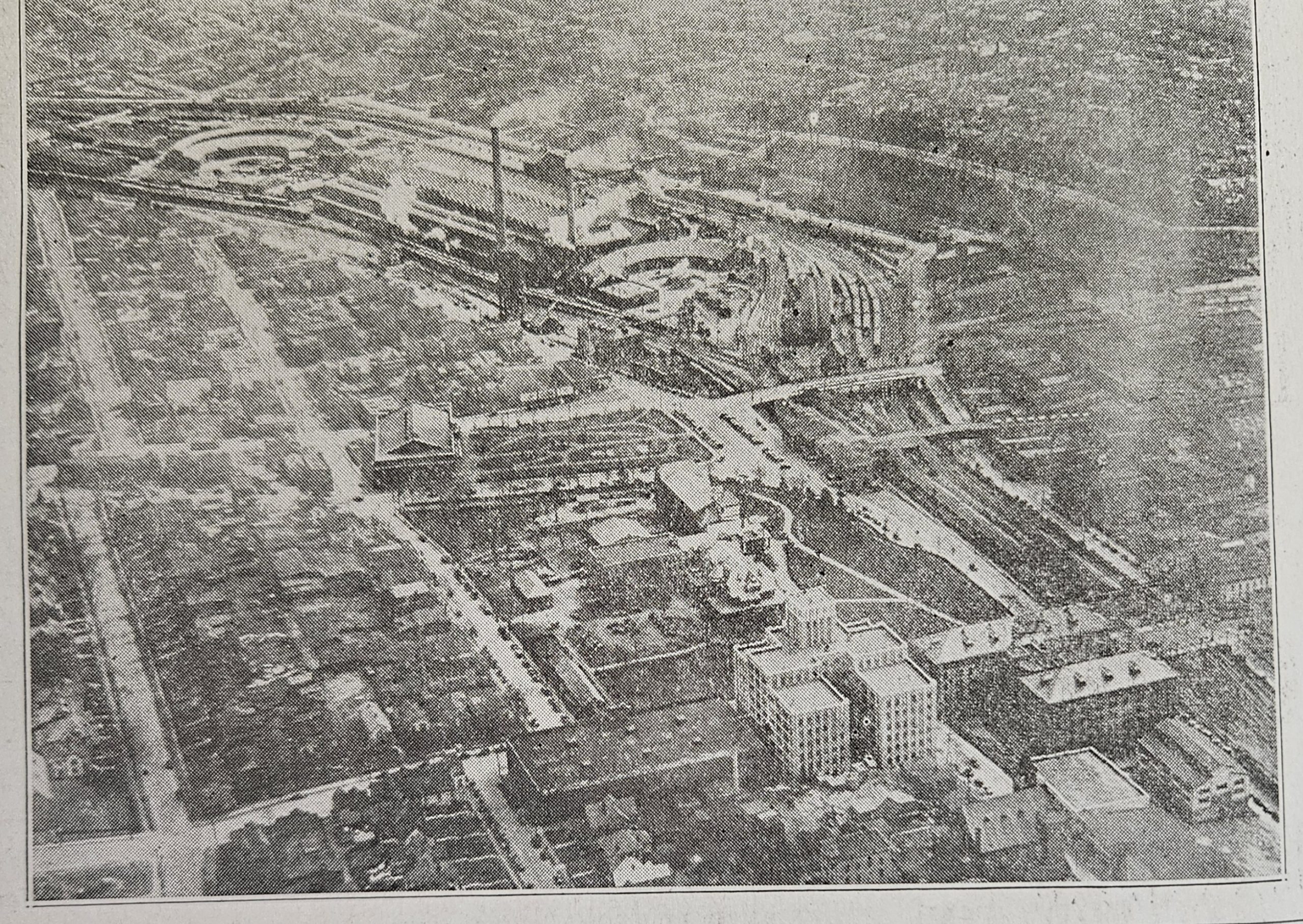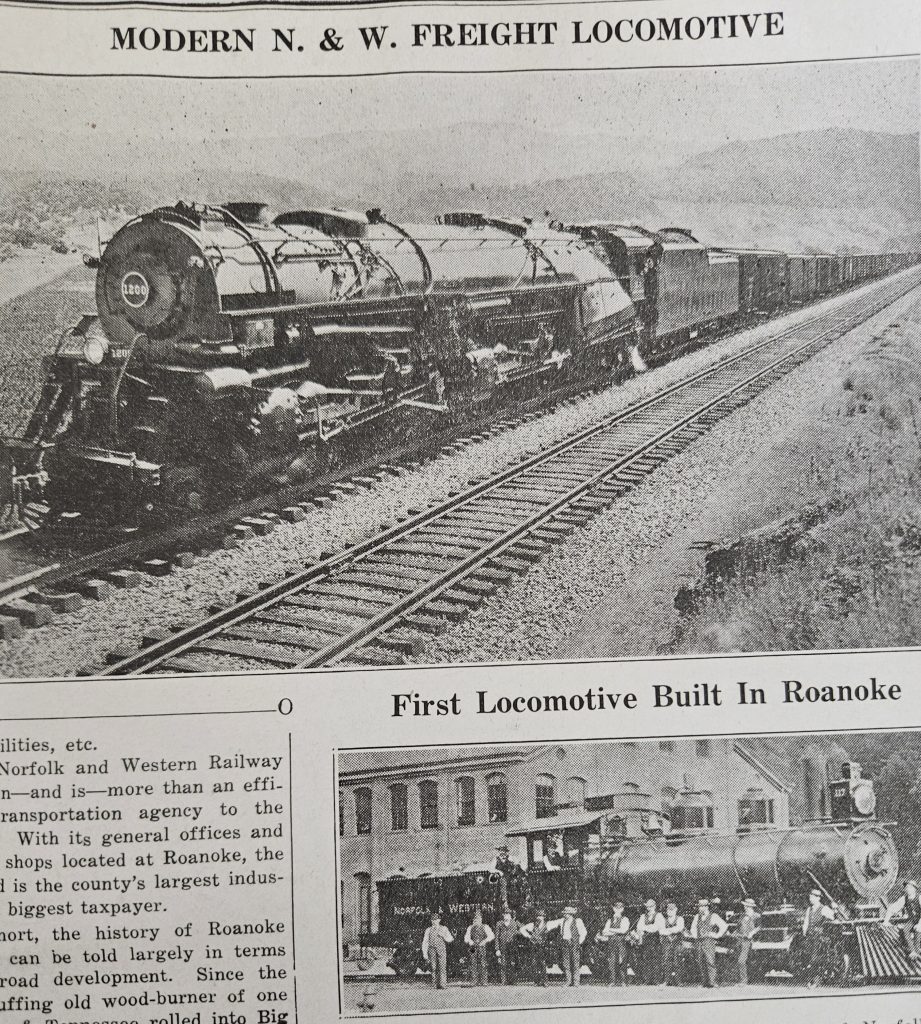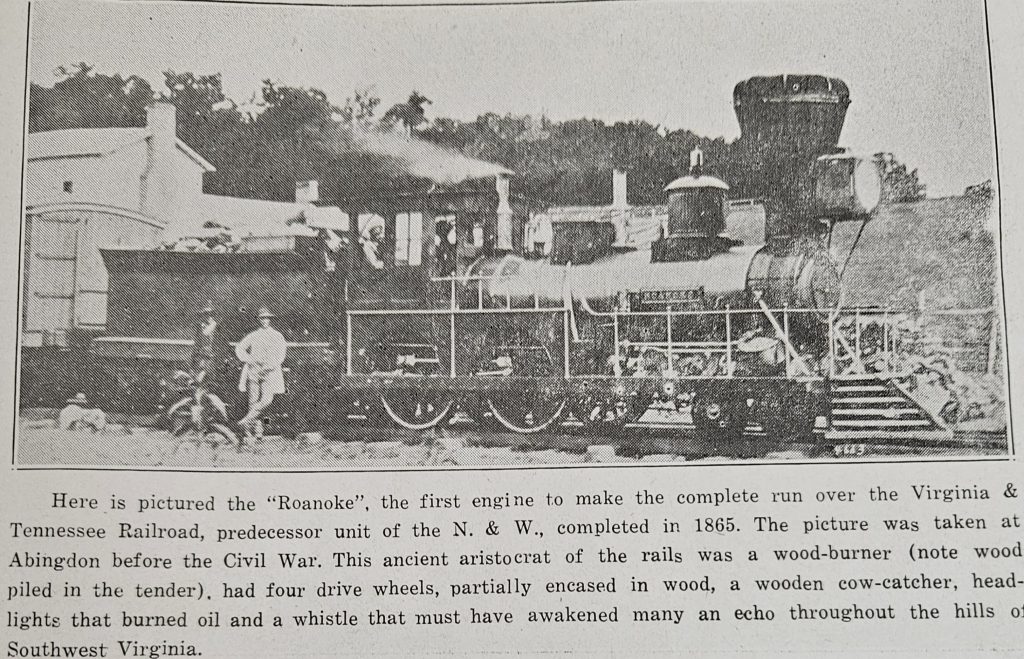
 Maintains One Of Largest And Most Modern Terminals In United States In Roanoke County
Maintains One Of Largest And Most Modern Terminals In United States In Roanoke County
From the 1938 centennial edition of The Times-Register
In 1838, Virginia witnessed two events that were to play a vital part in the development of the Commonwealth-the birth of a new county and the completion of one of the State’s first railroads.
It was on March 30, 1838, that Roanoke County, today one of the Old Dominion’s most important political sub-divisions, came into existence. Five months later-on September 7, 1838-a crude, little wood-burning engine, carrying carriage-like contraptions and loaded with excited, cheering passengers, puffed and snorted out of the town of Petersburg, Va., on the first run of the nine-mile journey to City Point, on the James River. While that event took place 170-odd miles from the eastern border of Roanoke County, it held a unique significance for this territory. For that primitive line was the City Point Railroad, the first unit of the Norfolk and Western Railway.
Linked by tradition, friendship and mutual progress, the railroad and the county are this year celebrating their 100th birthday anniversary.
Completion of the City Point line was the victorious culmination of a five-year struggle of a small group of pioneers to provide faster transportation for freight and passengers in their territory. But little did they dream that from the nine miles of strap rail would grow a major trunk line system of the nation, with approximately 5,000 miles of track, serving six states-Virginia, West Virginia, North Carolina, Ohio, Maryland and Kentucky. For 86 years of its century of life, the N&W and its predecessor lines have played a vital role in the development and progress of Roanoke County.
Large Terminals
Today, the railway maintains within the confines of Roanoke County one of the largest and most modern terminals in the United States and the largest on the system. With lines and connections to the north, east, south and west, the Norfolk and Western provides the industry and agriculture of the county with rail service which is recognized as outstanding in the nation.
Fourteen years after the initial run of the City Point Railroad a handful of inhabitants of a tiny Virginia village stood at the crossroads to the great mountains in the Southwest and witnessed an event that changed their destiny and the destiny of their descendants for generations to come. On November 1, 1852, a wheezing, wood-burning locomotive, pulling a train of passengers and freight, rumbled into Big Lick. Pioneer railroad builders had completed the Virginia & Tennessee Railroad (the second unit which later made up N&W) from Lynchburg to Big Lick, today Roanoke, the metropolis of the county and of Southwest Virginia. A little more than a month before-September 25- the railroad entered Roanoke County at Bonsack. On December 15, 1852, the line was completed to Salem.
The coming of this first little railway marked the beginning of the development of one of the richest sections of the State-Roanoke County and Southwest Virginia.
 Completed To Bristol
Completed To Bristol
On October 1, 1856-four years after the line entered Roanoke County-the V. & T. was completed to Bristol. That was another day of rejoicing for citizens of the county, for the long dreamed of railroad from Lynchburg through Salem and the Southwest, became a reality. The construction of the V. & T. started at Lynchburg on January 16, 1850.
President John Robinson McDaniel of the Virginia & Tennessee said in his report to the directors on the completion of the road, “You are not alone in your rejoicing. The merchant, the mechanic and the farmer unite with you-. It is a successful termination of one of the mighty struggles of our good old Commonwealth to show off the trappings of vassalage she has so long worn. It is a great advance up the ascent to commercial independence. The winter of your trouble is passed. A genial spring is now opening with its budding of future prosperity.”
The railroad president’s prediction was right. Roanoke County and its towns took on new life. The V. & T. prospered, and the territory traversed by the railroad prospered with it. Many new wonders and inventions of the age followed the building of the railway. In his report for 1857, the president of the Virginia & Tennessee reported to the board of directors that a telegraph line had been completed and was in operation between Lynchburg and Bristol. Said he: “The benefits of a telegraph along the line of a railroad cannot be questioned. It is an indispensable appendage.” In the next year, he reported that the railroad “has entered into a contract with the post office department for carrying United States mail once a day.” Later the service was increased to “twice daily upon a schedule of three days from Washington city to New Orleans.”
 The Virginia & Tennessee and its connecting lines were among the first and fastest carriers of “the news”. The agent of the Associated Press made arrangements for the transmission of news over the railroad because “it could be done considerably in advance of any other system between New York and New Orleans.”
The Virginia & Tennessee and its connecting lines were among the first and fastest carriers of “the news”. The agent of the Associated Press made arrangements for the transmission of news over the railroad because “it could be done considerably in advance of any other system between New York and New Orleans.”
The next great improvement on the V. & T. was the operation of sleeping cars (about 1860). A historian of the times relates: “Sleeping cars, a new invention, were introduced on the Virginia & Tennessee road. The newspapers say that they render sleeping really comfortable on the railroad train.”
Consolidation
The Virginia & Tennessee operated as such until June 1870, when it was consolidated with the Southside Railroad Company, which ran from Petersburg to Lynchburg; and the Norfolk & Petersburg Railroad, between those two points, as the Atlantic, Mississippi & Ohio Railroad. This road, with a continuous line between Norfolk and Bristol, resulted in the development of agriculture on a large scale. It created a market for the farmers, who before the coming of the railroad, produced only enough to supply the little market to which they were confined. It gave an outlet to the mineral products which were being mined as a result of this new means of transportation. New towns were springing up along the line. Property values were increasing.
Roanoke County’s second railroad was the Shenandoah Valley-another important predecessor unit of the Norfolk & Western system. The first train on this line, which operated from Hagerstown, Md., through the beautiful Shenandoah Valley, pulled into Roanoke on June 18, 1882. A detailed history of the road is contained elsewhere in this section of the paper.
- M. & O. R. Sold
Meanwhile, the Atlantic, Mississippi & Ohio Railroad was sold on February 10, 1881, for $8,605,000, subject to liens and encumbrances, and reorganized as the Norfolk & Western Railway Company. With splendid harbor facilities at Norfolk, on the Port of Hampton Roads, superb resources along its line in eastern and southwestern Virginia, and with the vast coal deposits of southwestern Virginia and southern West Virginia in view, the new company was capitalized at &25,000,000 and started extensive improvements.
Between 1881 and 1892 the railroad built three lines into the coal fields of Virginia and West Virginia and extending beyond into Ohio. These were the New River line, from New River Depot (now New River) to the coal deposits at Pocahontas, which was open for traffic in 1883; the Clinch Valley, which ran from Bluefield, Va., to Ironton, Ohio, completed in 1892. The Ohio Extension made connections with the Scioto Valley & New England Railroad, which ran to Columbus. The purchase of this road gave the N. & W. a western outlet for the increasing volume of coal mined in Virginia and West Virginia and a through line from Norfolk to the Middle West.
Open Coal Field Traffic
With the construction of these lines and the opening of the great coal fields, traffic on the railroad increased rapidly. Many branch lines were built to new coal properties. Tidewater coal terminals were built at Lambert Point. Much of the territory through which the railroad passed was transformed from a wilderness into a thriving section dotted with busy towns and communities. All of which contributed tremendously to the steady growth and development of Roanoke County and Southwest Virginia.
The construction of the Shenandoah Valley Railroad to Roanoke in 1881 was followed during the next several years by the removal of the general offices of that line from Lynchburg to Roanoke. The establishment of the offices here marked another period in the growth of the county and the city.
The next great step in Roanoke County’s development was the construction of the Roanoke Machine Works (later the Norfolk and Western Shops) between 1882 and 1883-the Magic City’s first big industry. The Machine Works employed about a thousand men and gave an impetus to business of every kind. In the three years from 1881 to 1884, the population of the town increased from about 600 to approximately 5,000.
Roanoke County was definitely on the way up. But still another railroad was to come to town. The third line of the present Norfolk and Western system to enter the county was the Roanoke and Southern Railway, which was completed between Winsto-Salem and Roanoke in March 1992. The new line, which was leased by Norfolk and Western during the month it was finished, brought more people, more industries and greater prosperity to the territory. Thus, another era in the county’s growth was featured by railroad development.
On September 24, 1896, the Norfolk and Western Railway Company was reorganized as the Norfolk and Western Railway Company. In October, the N. & W. purchased the Lynchburg & Durham, operating between Lynchburg and Durham, N. C., and in December, the Roanoke & Southern, both of which had been previously operated by lease. The Cincinnati, Portsmouth & Virginia Railroad Company, running between Sciotoville, Ohio and Cincinnati, was conveyed to the N. & W. in October 1901.
Since then, the N. & W. has spent millions of dollars in a consistent program of expansion, improvements and betterments, including the electrification of 210 miles of track over mountain grades in West Virginia, double tracking, the installation of automatic signals and interlocking plants; and the enlargement and construction of great terminals at Norfolk, Roanoke, Bluefield, Williamson, Portsmouth and Columbus.
New Construction
Regarded as one of the most progressive and efficiently operated railroads in the country, the Norfolk and Western is one of the few carriers which has increased its mileage within recent years by construction of new lines. Since 1928, the railway has built three new branch lines in Virginia and West Virginia to tap some of the richest coal deposits in the two states. The construction of the Buchanan Branch Extension in Buchanan County, Virginia-a 42-mile line completed and placed in operation during the latter part of 1936-is regarded as one of the most important development projects undertaken in Virginia within recent years.
Other recent improvements made by the railway include the laying of thousands of tons of new 131-pound steel rail, the air-conditioning and modernization of passenger equipment, the construction in the Roanoke Shops and the purchase of scores of new locomotives and thousands of new cars, building of new general office facilities, etc.
The Norfolk and Western Railway has been-and is-more than an efficient transportation agency to the county. With its general offices and largest shops located at Roanoke, the railroad is the county’s largest industry and biggest taxpayer.
In short, the history of Roanoke County can be told largely in terms of railroad development. Since the first puffing old wood-burner of one Virginia & Tennessee rolled into Big Lick nearly 86 years ago, the progress and prosperity of the railroad and the county have been intimately bound up with the other. Roanoke County and Norfolk and Western Railway have literally grown up together.
-Prepared by Lisa King




